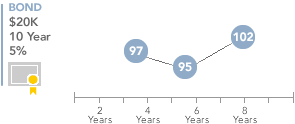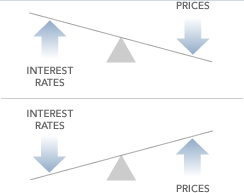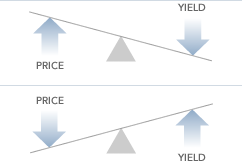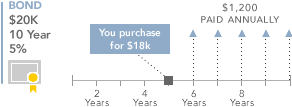If you buy a new issue bond or certificate of deposit (CD) and plan to keep it to maturity, changing prices, market interest rates, and yields typically do not affect you, unless the bond or CD is called. But investors needn't only buy bonds or CDs directly from the issuer and hold them until maturity; instead, they can be bought from and sold to other investors on what's called the secondary market. Similar to stocks, bond and CD prices can be higher or lower than the face value of the security because of the current economic environment and the financial health of the issuer.
This article refers frequently to bonds, but readers can also substitute the word "bond(s)" for "brokered CDs." Brokered CDs are similar to bank CDs, only they're designed to be held in brokerage accounts and behave like bonds in their trading and pricing characteristics.
How price is measured
Price is important when you intend to trade bonds with other investors. A bond's price is what investors are willing to pay for an existing bond.
In the online offering table and statements you receive, bond prices are provided in terms of percentage of face (par) value.
Example: You are considering buying a corporate bond. It has a face value of $20,000. At 3 points in time, its price—what investors are willing to pay for it—changes from 97, to 95, to 102.

Price and interest rates
The price investors are willing to pay for a bond can be significantly affected by prevailing interest rates. If prevailing interest rates are higher than when the existing bonds were issued, the prices on those existing bonds will generally fall. That's because new bonds are likely to be issued with higher coupon rates as interest rates increase, making the old or outstanding bonds generally less attractive unless they can be purchased at a lower price. So, higher interest rates mean lower prices for existing bonds.
If interest rates decline, however, prices of existing bonds usually increase, which means an investor can sometimes sell a bond for more than the purchase price, since other investors are willing to pay a premium for a bond with a higher interest payment, also known as a coupon.

This relationship can also be expressed between price and yield. The yield on a bond is its return expressed as an annual percentage, affected in large part by the price the buyer pays for it. If the prevailing yield environment declines, prices on those bonds generally rise. The opposite is true in a rising yield environment—in short, prices generally decline.

Let's say you buy a CD with a coupon rate of 3%. While you own the CD, the prevailing interest rate rises to 5% and then falls to 1%.
1. The prevailing interest rate is the same as the CD's coupon rate. The price of the CD is 100, meaning that buyers are willing to pay you the full $20,000 for your CD.
2. Prevailing interest rates rise to 5%. Buyers can get around 5% on new CDs, so they'll only be willing to buy your bond at a discount. In this example, the price drops to 91, meaning they are willing to pay you $18,200 ($20,000 x .91). At a price of 91, the yield to maturity of this CD now matches the prevailing interest rate of 5%.
3. The prevailing interest rate drops to 1%. Buyers can only get 1% on new CDs, so they are willing to pay extra for your CD, because it pays higher interest. In this example, the price rises to 104, meaning they are willing to pay you $20,800 (20,000 x 1.04). At a price of 104, the yield to maturity of this CD now matches the prevailing interest rate of 1%.
More factors that affect price
The financial health of the company or government entity issuing a bond affects the coupon that the bond is issued with—higher-rated bonds issued by creditworthy institutions generally offer lower interest rates, while those less financially secure companies or governments will have to offer higher rates to entice investors.
Similarly, the creditworthiness of the issuer will affect the bond's price on the secondary market. If the issuer is financially strong, investors are willing to pay more since they are confident that the issuer will be capable of paying the interest on the bond and pay off the bond at maturity. But if the issuer encounters financial problems—and especially if it's downgraded by one of the ratings agencies (for more, see Bond ratings)—then investors may become less confident in the issuer. As a result, prices may fall.
The risk that the financial health of the issuer will deteriorate, known as credit risk, increases the longer the bond's maturity. CDs are not subject to credit risk, as they are FDIC insured, but they are still subject to interest rate risk, which can be caused by inflation.
Inflationary conditions generally lead to a higher interest rate environment. Therefore, inflation has the same effect as interest rates. When the inflation rate rises, the price of a bond tends to drop, because the bond may not be paying enough interest to stay ahead of inflation. Remember that a fixed-rate bond’s coupon rate is generally unchanged for the life of the bond.
The longer a bond's maturity, the more chance there is that inflation will rise rapidly at some point and lower the bond's price. That's one reason bonds with a long maturity offer somewhat higher interest rates: They need to do so to attract buyers who otherwise would fear a rising inflation rate. That's one of the biggest risks incurred when agreeing to tie up your money for, say, 30 years.
Minimizing bond and CD price confusion
Bond and CD pricing involves many factors, but determining the price of a bond or CD can be even harder because of how they are traded. Because stocks are traded throughout the day, it's easier for investors to know at a glance what other investors are currently willing to pay for a share. But with bonds and CDs, the situation is often not so straightforward.
The price you see on the positions tab of your statement for many fixed-income securities, especially those that are not actively traded, is a price that is derived by industry pricing providers, rather than the last-trade price (as with stocks).
The derived price takes into account factors such as coupon rate, maturity, and credit rating. The price is also based on large trading blocks. But the price may not take into account every factor that can impact the actual price you would be offered if you actually attempted to sell the bond. Derived pricing is commonly used throughout the industry.
It's important to remember that as long as the security's issuer doesn't default on the debt, then as long as you hold your bond or CD to maturity, it will mature at the full face (or par) value and pay any interest earned. All brokered CDs offered at Fidelity are subject to FDIC insurance, and therefore default is not a consideration for CD owners.
Most bonds are not listed on an exchange, although there are a few corporate bonds trading on the New York Stock Exchange (NYSE). Of the hundreds of thousands of bonds that are registered in the United States, less than 100,000 are generally available on any given day. These bonds will be quoted with an offered price, the price the dealer is asking the investor to pay. Treasury and corporate bonds are more frequently also listed with bid prices, the price investors would receive if they're selling the bond. Less liquid bonds, such as municipal bonds, are rarely quoted with a dealer's bid price.
If the bid price is not listed, you can request a bid via the bond or CD trade ticket online by selecting Request Bid in the Action dropdown menu.
Yield
Yield is the anticipated return on an investment, expressed as an annual percentage. For example, a 6% yield means that the investment averages 6% return each year. There are several ways to calculate yield, but whichever way you calculate it, the relationship between price and yield remains constant: The higher the price you pay for a bond or CD, the lower the yield, and vice versa.
Current yield is the simplest way to calculate yield:

For example, if you buy a bond paying $1,200 each year and you pay $20,000 for it, its current yield is 6%. While current yield is easy to calculate, it is not as accurate a measure as yield to maturity.
Yield to maturity is often the yield that investors inquire about when considering a bond or CD. Yield to maturity requires a complex calculation. It considers the following factors.
- Coupon rate—The higher a bond or CD's coupon rate, or interest payment, the higher its yield. That's because each year the bond or CD will pay a higher percentage of its face value as interest.
- Price—The higher a bond or CD's price, the lower its yield. That's because an investor buying the bond or CD has to pay more for the same return.
- Years remaining until maturity—Yield to maturity factors in the compound interest you can earn on a bond or CD if you reinvest your interest payments.
- Difference between face value and price—If you keep a bond or CD to maturity, you receive the bond or CD's face value. The actual price you paid for the bond or CD may be more or less than the face value. Yield to maturity factors in this difference.
For example, say a bond has a face value of $20,000. You buy it at 90, meaning that you pay 90% of the face value, or $18,000. It is 5 years from maturity.
The bond's current yield is 6.7% ($1,200 annual interest / $18,000 x 100).
But the bond's yield to maturity in this case is higher. It considers that you can achieve compounding interest by reinvesting the $1,200 you receive each year. It also considers that when the bond matures, you will receive $20,000, which is $2,000 more than what you paid.

Yield to call is the yield calculated to the next call date, instead of to maturity, using the same formula.
Yield to worst is the worst yield you may experience assuming the issuer does not default. It is the lower of yield to call and yield to maturity.
It is possible that 2 bonds having the same face value and the same yield to maturity nevertheless offer different interest payments. That's because their coupon rates may not be the same.
Yield curve and maturity date
A yield curve is a graph demonstrating the relationship between yield and maturity for a set of similar securities. A number of yield curves are available. A common one that investors consider is the US Treasury yield curve.
The shape of a yield curve can help you decide whether to purchase a long-term or short-term bond. Investors generally expect to receive higher yields on long-term bonds. That's because they expect greater compensation when they loan money for longer periods of time. Also, the longer the maturity, the greater the effect of a change in interest rates on the bond's price.
